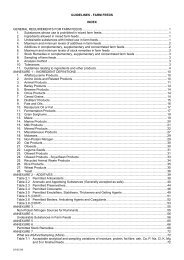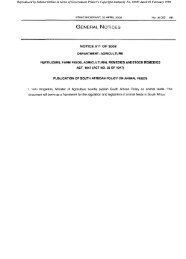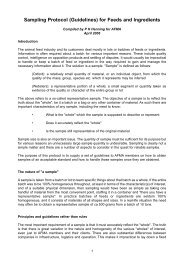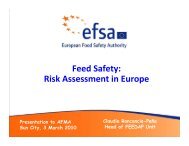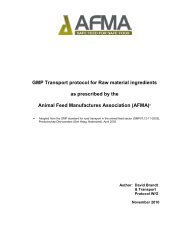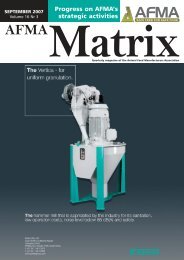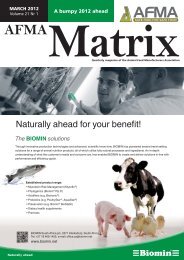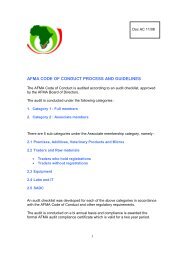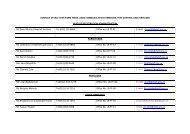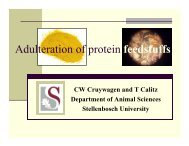You also want an ePaper? Increase the reach of your titles
YUMPU automatically turns print PDFs into web optimized ePapers that Google loves.
Benchmarking is a crucial aspect<br />
of business – how else will you<br />
form an idea of how you compare<br />
to the rest of the players<br />
in your particular industry?<br />
With this in mind, we asked a few industry<br />
leaders to compare the local animal feeds<br />
industry to the rest of the world.<br />
Terry Wiggill, Zeno Bester, Tim Horne<br />
and Jackie Tucker from Chemuniqué<br />
International<br />
The South African feed industry has been<br />
challenged this past year by a multitude of<br />
factors. The increase in soy oilcake prices<br />
around June/July 2012 caused an increase<br />
in feed prices, resulting in escalated production<br />
costs in the poultry industry in<br />
particular.<br />
“The South African feed<br />
industry is proud to have<br />
a number of world-class<br />
nutritionists who have<br />
years of experience in<br />
the industry whilst keeping<br />
abreast of international<br />
developments in the<br />
science of animal nutrition”<br />
The import of “cheap” poultry meat from<br />
countries such as Brazil meant producers<br />
could not increase meat prices to offset the<br />
increased feed prices and as a result, many<br />
poultry operations suffered greatly. Much<br />
of this can be prevented, should the government<br />
strive to protect our local poultry<br />
industry against imported meat produced<br />
more cost-effectively in countries abroad<br />
where producers are receiving government<br />
grants.<br />
State of the South African<br />
animal feed industry<br />
By Izak Hofmeyr<br />
On a positive note, it has to be mentioned<br />
that the South African feed industry<br />
is on par with other feed manufacturers<br />
and producers in the international arena.<br />
All South African feed manufacturers are<br />
governed by strict legislation such as the<br />
Fertilisers, Farm Feeds, Agricultural Remedies<br />
and Stock Remedies Act (Act 36 of 1947), and<br />
adhere to these regulations by constantly<br />
scrutinising and analysing feed before it<br />
enters the food chain. An example is the<br />
regulations on undesirable levels as stipulated<br />
by the Feeds Act, of which all feed<br />
manufacturers are aware, as these substances<br />
could affect the entire feed and<br />
food chain.<br />
Experts and technology<br />
South African feed manufacturers, as members<br />
of the Animal Feed Manufacturers Association<br />
(<strong>AFMA</strong>), are also governed by the<br />
<strong>AFMA</strong> Code of Conduct, which ensures that<br />
all members adhere to the strictest regulations<br />
and implement the necessary control<br />
measures to ensure safe feed for safe food<br />
are produced at all times.<br />
The South African feed industry is<br />
proud to have a number of world-class nutritionists<br />
who have years of experience in<br />
the industry whilst keeping abreast of international<br />
developments in the science of<br />
animal nutrition. Poultry, pork, meat and<br />
dairy producers in this country are skilled<br />
and well informed about the nutritional<br />
requirements of their animals, making use<br />
of state-of-the-art modern equipment and<br />
applying the necessary financial principles<br />
to ensure that their operations are profitable.<br />
These producers insist on only the<br />
best animal feed, advice and support to<br />
feed the nation.<br />
However, it is unfortunate that we have<br />
so many eager, knowledgeable producers<br />
and feed manufacturers, but have to rely<br />
on information and knowledge generated<br />
abroad. A very limited amount of research<br />
is performed within our borders and in order<br />
for this industry to stay current, adaptable<br />
and progressive, we need to focus on<br />
and invest in local research to ensure we<br />
evaluate and develop our feed products,<br />
farming practices etc. under local conditions.<br />
It is essential to invest in local research<br />
to allow our feed industry to keep<br />
up with the ever growing demand for food<br />
in South Africa.<br />
Effect of input cost<br />
The continued pressure driving down margins<br />
for livestock producers has predominantly<br />
been due to the import of foreign<br />
produce, relatively high raw material costs,<br />
significant increases in electricity costs<br />
and the recent lift in the minimum wage<br />
within the agricultural sector. The result of<br />
this is that many of the smaller business<br />
operations no longer have a viable business<br />
model, and have been forced to exit<br />
the market.<br />
This is particularly apparent in the dairy<br />
sector, where over the last 20 years the<br />
number of commercial producers has decreased<br />
dramatically, but total cow numbers<br />
have increased. Thus the sector is<br />
dominated by fewer producers over time.<br />
The other livestock production enterprises<br />
show similar trends, and this will significantly<br />
impact the feed industry and its interaction<br />
with the market in the future.<br />
Another one of the main challenges we<br />
see facing the future of the industry, is the<br />
distribution of agricultural land. Some of<br />
the most productive agricultural land in<br />
South Africa is state-owned and has been<br />
redistributed to rural farmers. However,<br />
the challenge is that these farmers do not<br />
own this land to use as collateral for bank<br />
loans and are therefore not able to use it to<br />
its full potential.<br />
This limits investment in possible expansion<br />
of production buildings, purchasing<br />
cheaper animal feed in the cities and<br />
Feed industry<br />
<strong>AFMA</strong> MATRIX ● APRIL <strong>2013</strong> 7



